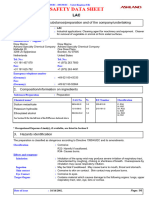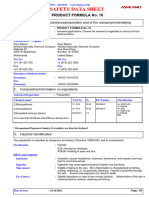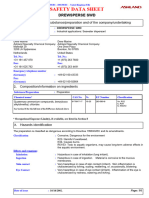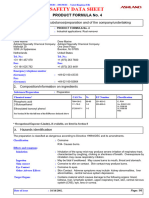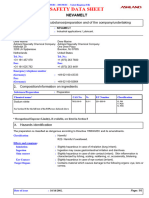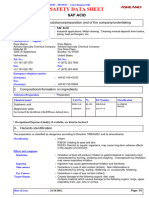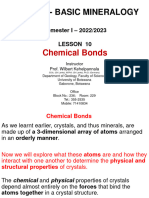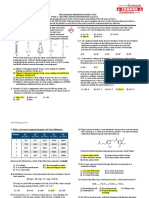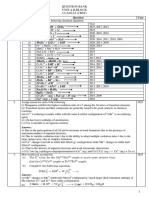Vtrdc5kub
Vtrdc5kub
Uploaded by
Nandar Min HtetCopyright:
Available Formats
Vtrdc5kub
Vtrdc5kub
Uploaded by
Nandar Min HtetOriginal Title
Copyright
Available Formats
Share this document
Did you find this document useful?
Is this content inappropriate?
Copyright:
Available Formats
Vtrdc5kub
Vtrdc5kub
Uploaded by
Nandar Min HtetCopyright:
Available Formats
Conforms to 91/155/EEC - 2001/58/EC - United Kingdom (UK)
SAFETY DATA SHEET
AMERZINE Ampoule Testkit
1. Identification of the substance/preparation and of the company/undertaking
Product name : AMERZINE Ampoule Testkit
Synonyms : AMERZINE Ampoule Testkit - Refill
Manufacturer / Supplier :
Drew Marine Drew Marine
Ashland Specialty Chemical Company Ashland Specialty Chemical Company
Malledijk 20 One Drew Plaza
3208 LA Spijkenisse Boonton, NJ 07005
Netherlands United States
Tel. No.: Tel. No.:
+31 181 457 070 +1 (973) 263 7600
Fax: Fax:
+31 181 625 792 +1 (973) 263 4491
Emergency telephone number
(Germany) : +49 621 60-43333
Fax:
(Germany) : +49 621 60-92664
2. Composition/information on ingredients
Substance/Preparation : Preparation
Chemical name* CAS No. % EC Number Classification
1,2-Ethane diol 107-21-1 50-60 203-473-3 Xn; R22
Methanol 67-56-1 10-20 200-659-6 F; R11
T; R23/24/25,
39/23/24/25
Hydrochloric acid 7647-01-0 1-5 231-595-7 C; R34
Xi; R37
See Section 16 for the full text of the R Phrases declared above
* Occupational Exposure Limit(s), if available, are listed in Section 8
3. Hazards identification
The preparation is classified as dangerous according to Directive 1999/45/EC and its amendments.
Classification : Toxic
R10- Flammable.
R20/21/22- Harmful by inhalation, in contact with skin and if swallowed.
R39/23/24/25- Toxic: danger of very serious irreversible effects through
inhalation, in contact with skin and if swallowed.
Effects and symptoms
Inhalation : May be fatal if inhaled.
Ingestion : May be fatal if swallowed.
Skin contact : Severe over-exposure can result in death.
Target Organs : Contains material which causes damage to the following organs: lungs, liver,
gastrointestinal tract, upper respiratory tract, skin, central nervous system
(CNS), eye, lens or cornea.
Date of issue : 10/16/2002. Page: 1/6
AMERZINE Ampoule Testkit
4. First-aid measures
First-Aid measures
Inhalation : If inhaled, remove to fresh air. If not breathing, give artificial respiration. If
breathing is difficult, give oxygen. Obtain medical attention immediately.
Ingestion : If swallowed, do not induce vomiting unless directed to do so by medical
personnel. Never give anything by mouth to an unconscious person. Loosen
tight clothing such as a collar, tie, belt or waistband. Obtain medical attention
immediately.
Skin contact : In case of contact, immediately flush skin copiously with water for at least 15
minutes while removing contaminated clothing and shoes. Cold water may be
used. Wash clothing before reuse. Clean shoes thoroughly before reuse.
Obtain medical attention immediately.
Eye Contact : Check for and remove any contact lenses. In case of contact, immediately
flush eyes with a copious amount of water for at least 15 minutes. Cold water
may be used. Obtain medical attention.
5. Fire-fighting measures
Extinguishing Media
Suitable : SMALL FIRE: Use dry chemical powder or CO2.
LARGE FIRE: Use alcohol foam, water spray or fog. Cool containing vessels
with water jet in order to prevent pressure build-up, autoignition or explosio
Hazardous thermal (de)composition : These products are carbon oxides (CO, CO2) and water, halogenated
products compounds.
Protection of fire-fighters : Fire fighters should wear self-contained positive pressure breathing apparatus
(SCBA) and full turnout gear.
6. Accidental release measures
Personal Precautions : Splash goggles. Full suit. Vapour respirator. Boots. Gloves. A self-contained
breathing apparatus should be used to avoid inhalation of the product.
Suggested protective clothing might not be sufficient; consult a specialist
BEFORE handling this product.
Environmental precautions and : Keep away from heat. Keep away from sources of ignition. Stop leak if
cleanup methods without risk. Absorb with dry earth, sand or other noncombustible materia
Use water spray to reduce vapours. Prevent entry into sewers, basements or
confined areas; dike if needed. Call for assistance on disposal.Neutralize
the residue with a dilute solution of sodium carbonate.
Note: See section 8 for personal protective equipment and section 13 for waste disposal.
7. Handling and storage
Handling : Keep locked up. Keep away from heat. Keep away from sources of ignition.
Ground all equipment containing material. Do not breathe
gas/fumes/vapour/spray. Wear suitable protective clothing. If ingested, seek
medical advice immediately and show the container or the label. Keep away
from incompatibles such as oxidizing agents, acids, alkalis.
Storage : Store in a segregated and approved area. Keep container in a cool,
well-ventilated area. Keep container tightly closed and sealed until ready f
use. Avoid all possible sources of ignition (spark or flame).
Packaging materials
Recommended use : Use original container.
Date of issue : 10/16/2002. Page: 2/6
AMERZINE Ampoule Testkit
8. Exposure controls/personal protection
Engineering measures : Provide exhaust ventilation or other engineering controls to keep the airborne
concentrations of vapours below their respective occupational exposure limits.
Ensure that eyewash stations and safety showers are close to the workstation
location.
Hygiene measures : Wash hands, forearms, and face thoroughly after handling compounds and
before eating, smoking, using lavatory, and at the end of day.
Occupational Exposure Limits
Ingredient Name Occupational Exposure Limits
1,2-Ethane diol EH40-OES (United Kingdom (UK), 2001). Notes: OES
STEL: 125 mg/m3 Form: Vapour
TWA: 10 mg/m3 Form: Particulate
TWA: 60 mg/m3 Form: Vapour
Methanol EH40-OES (United Kingdom (UK), 2001). skin Notes:
OES
STEL: 333 mg/m3
STEL: 250 ppm
TWA: 266 mg/m3
TWA: 200 ppm
Hydrochloric acid EH40-OES (United Kingdom (UK), 2001). Notes: OES
STEL: 8 mg/m3 Form: Multiple forms
STEL: 5 ppm Form: Multiple forms
TWA: 2 mg/m3 Form: Multiple forms
TWA: 1 ppm Form: Multiple forms
Respiratory system : Wear appropriate respirator when ventilation is inadequate. Vapour respirator.
Skin and body : Lab coat.
Hands : Impervious gloves.
Eyes : Safety glasses.
9. Physical and chemical properties
Physical state : Liquid.
Colour : Colourless to light yellow.
Odour : Odourless.
Odour threshold : The lowest known value is 100 ppm (Methanol).
Boiling point : 115°C (239°F)
Melting point : -8°C (18°F)
Density : 0.98 g/cm3
Vapour density : The highest known value is 2.14 (Air = 1) (1,2-Ethane diol).
Vapour pressure : The highest known value is 12.93 kPa (97 mmHg) (at 20°C) (Methanol).
Evaporation Rate : 0.36 (Water) compared to n-Butyl acetate
Solubility : Easily soluble in cold water.
pH : Acidic.
Flash point : CLOSED CUP: 51°C (123.8°F).
Autoignition temperature : The lowest known value is 399.9°C (751.8°F) (1,2-Ethane diol).
Lower explosion limit : The greatest known range is LOWER: 6% UPPER: 36.5% (Methanol)
Date of issue : 10/16/2002. Page: 3/6
AMERZINE Ampoule Testkit
10. Stability and reactivity
Stability : The product is stable.
Materials to avoid : Reactive with oxidizing agents, acids, alkalis.
Hazardous decomposition products : These products are carbon oxides (CO, CO2) and water, halogenated
compounds.
11. Toxicological information
Acute toxicity
Ingredient Name Test Result Route Species
1,2-Ethane diol LD50 4700 mg/kg Oral Rat
LD50 1650 mg/kg Oral Cat
LD50 5510 mg/kg Oral Mouse
LDLo 398 mg/kg Oral Human/30 min
LDLo 786 mg/kg Oral Human/30 min
Methanol LD50 5628 mg/kg Oral Rat
LD50 14200 Oral Rabbit
mg/kg
LD50 7300 mg/kg Oral Mouse
LD50 15800 Dermal Rabbit
mg/kg
LDLo 143 mg/kg Oral human
LDLo 428 mg/kg Oral human
LDLo 6422 mg/kg Oral man
LDLo 393 mg/kg Dermal Monkey
LC50 83200 Inhalation Rat
mg/m3 (4
hours)
Hydrochloric acid LD50 915 mg/kg Oral Rat
LD50 151 mg/kg Oral Mouse
LD50 2950 mg/kg Oral Mouse
LDLo 150 mg/kg Oral Mouse
LDLo 110 mg/kg Oral Mouse
Chronic toxicity : Repeated exposure to an highly toxic material may produce general
deterioration of health by an accumulation in one or many human organs.
Carcinogenic effects : Not available.
Mutagenic Effects : Not available.
Reproduction toxicity : Not available.
12. Ecological information
Ecotoxicity Data
Ingredient Name Species Period Result
1,2-Ethane diol Fish (LC50) 96 hours 53000 mg/l
Daphnia (EC50) 24 hours 49000 mg/l
Algae (IC50) 72 hours 10000 mg/l
Methanol Trout (LC50) 96 hours 10000 mg/l
Daphnia (EC50) 48 hours 15600 mg/l
Persistence/degradability : Not available.
Date of issue : 10/16/2002. Page: 4/6
AMERZINE Ampoule Testkit
13. Disposal considerations
Methods of disposal ; Waste of : Waste must be disposed of in accordance with federal, state and local
residues ; Contaminated packaging environmental control regulations.
European Waste Catalogue (EWC) : 16 05 03
Hazardous Waste : The classification of the product may meet the criteria for a hazardous waste.
Additional Information : 16 05 03 other waste containing organic chemicals, e.g. lab chemicals not
otherwise specified
14. Transport information
International transport regulations
Land - Road/Railway
UN number : 3316
Proper shipping name : CHEMICAL KIT
ADR/RID Class : 3
Packing group : III
ADR/RID label :
Other information : -
Sea
UN number : 3316
Proper shipping name : CHEMICAL KIT
IMDG Class : 3
Packing group : III
IMDG label :
Other information : Emergency Schedules (EmS)
8-15
15. Regulatory information
EU Regulations
Hazard symbol(s) :
Toxic
Risk Phrases : R10- Flammable.
R20/21/22- Harmful by inhalation, in contact with skin and if swallowed.
R39/23/24/25- Toxic: danger of very serious irreversible effects through
inhalation, in contact with skin and if swallowed.
Safety Phrases : S16- Keep away from sources of ignition - No smoking.
S23- Do not breathe [***].
S36/37- Wear suitable protective clothing and gloves.
S45- In case of accident or if you feel unwell, seek medical advice
immediately (show the label where possible).
Contains : 1,2-Ethane diol 203-473-3
Methanol 200-659-6
Date of issue : 10/16/2002. Page: 5/6
AMERZINE Ampoule Testkit
Product Use : Classification and labelling have been performed according to EU directives
67/548/EEC, 88/379/EEC, including amendments and the intended use.
- Industrial applications.
16. Other information
Full text of R-Phrases with no. : R11- Highly flammable.
appearing in Section 2 - United R22- Harmful if swallowed.
Kingdom (UK) R23/24/25- Toxic by inhalation, in contact with skin and if swallowed.
R34- Causes burns.
R37- Irritating to respiratory system.
R39/23/24/25- Toxic: danger of very serious irreversible effects through
inhalation, in contact with skin and if swallowed.
Text of classifications appearing in : F - Highly flammable
Section 2 - United Kingdom (UK) T - Toxic
C - Corrosive
Xn - Harmful
Xi - Irritant
HISTORY
Date of printing : 10/21/2002.
Date of issue : 10/16/2002.
Version : 3
Notice to Reader
To the best of our knowledge, the information contained herein is accurate. However, neither the above named supplier nor
any of its subsidiaries assumes any liability whatsoever for the accuracy or completeness of the information contained
herein.
Final determination of suitability of any material is the sole responsibility of the user. All materials may present unknown
hazards and should be used with caution. Although certain hazards are described herein, we cannot guarantee that these
are the only hazards that exist.
Date of issue Version
10/16/2002. 3 Page: 6/6
You might also like
- Aashto M 248 1991 (R 2012)Document6 pagesAashto M 248 1991 (R 2012)Eko SupriantoNo ratings yet
- Chemistry: Laboratory ManualDocument5 pagesChemistry: Laboratory ManualJulius RimasNo ratings yet
- Peb6c5kubDocument6 pagesPeb6c5kubNandar Min HtetNo ratings yet
- 1266 9uh7c5kubDocument6 pages1266 9uh7c5kubNandar Min HtetNo ratings yet
- 0057 M4t2c5kubDocument6 pages0057 M4t2c5kubNandar Min HtetNo ratings yet
- 0005 Ll64c5kubDocument6 pages0005 Ll64c5kubNandar Min HtetNo ratings yet
- 1725 Hnu5c5kubDocument5 pages1725 Hnu5c5kubNandar Min HtetNo ratings yet
- 6598 Gvecc5kubDocument6 pages6598 Gvecc5kubNandar Min HtetNo ratings yet
- 0026 Bgvac5kubDocument5 pages0026 Bgvac5kubNandar Min HtetNo ratings yet
- 0007 Ok15c5kubDocument5 pages0007 Ok15c5kubNandar Min HtetNo ratings yet
- 5 C 5 KubDocument6 pages5 C 5 KubNandar Min HtetNo ratings yet
- 1731 78mtc5kubDocument5 pages1731 78mtc5kubNandar Min HtetNo ratings yet
- 0097 3s68c5kubDocument5 pages0097 3s68c5kubNandar Min HtetNo ratings yet
- 4757 54a6c5kubDocument6 pages4757 54a6c5kubNandar Min HtetNo ratings yet
- 0091 Lpfvc5kubDocument5 pages0091 Lpfvc5kubNandar Min HtetNo ratings yet
- 4139 Jo0mc5kubDocument6 pages4139 Jo0mc5kubNandar Min HtetNo ratings yet
- 0060 Me5pc5kubDocument5 pages0060 Me5pc5kubNandar Min HtetNo ratings yet
- 1265 Tvtnc5kubDocument5 pages1265 Tvtnc5kubNandar Min HtetNo ratings yet
- 1272 0s3cc5kubDocument5 pages1272 0s3cc5kubNandar Min HtetNo ratings yet
- 1279 Srvmc5kubDocument6 pages1279 Srvmc5kubNandar Min HtetNo ratings yet
- 4608 Vpmmc5kubDocument5 pages4608 Vpmmc5kubNandar Min HtetNo ratings yet
- 4907 Avkbc5kubDocument5 pages4907 Avkbc5kubNandar Min HtetNo ratings yet
- 6623 Cp4qc5kubDocument5 pages6623 Cp4qc5kubNandar Min HtetNo ratings yet
- 0011 1550c5kubDocument5 pages0011 1550c5kubNandar Min HtetNo ratings yet
- 1274 N48uc5kubDocument6 pages1274 N48uc5kubNandar Min HtetNo ratings yet
- 1213 28v5c5kubDocument5 pages1213 28v5c5kubNandar Min HtetNo ratings yet
- 5148 L85ac5kubDocument5 pages5148 L85ac5kubNandar Min HtetNo ratings yet
- 0082 Hvipc5kubDocument5 pages0082 Hvipc5kubNandar Min HtetNo ratings yet
- 1270 Lh7vc5kubDocument6 pages1270 Lh7vc5kubNandar Min HtetNo ratings yet
- 9511 Lktjc5kubDocument5 pages9511 Lktjc5kubNandar Min HtetNo ratings yet
- 0098 T8f8c5kubDocument5 pages0098 T8f8c5kubNandar Min HtetNo ratings yet
- 1259 P8e7c5kubDocument5 pages1259 P8e7c5kubNandar Min HtetNo ratings yet
- 1295 1047c5kubDocument6 pages1295 1047c5kubNandar Min HtetNo ratings yet
- 6519 K176c5kubDocument6 pages6519 K176c5kubNandar Min HtetNo ratings yet
- 1726 Q99kc5kubDocument5 pages1726 Q99kc5kubNandar Min HtetNo ratings yet
- 1717 43eoc5kubDocument6 pages1717 43eoc5kubNandar Min HtetNo ratings yet
- 9534 G499c5kubDocument5 pages9534 G499c5kubNandar Min HtetNo ratings yet
- 5247 Qahtc5kubDocument5 pages5247 Qahtc5kubNandar Min HtetNo ratings yet
- 1269 5vp7c5kubDocument6 pages1269 5vp7c5kubNandar Min HtetNo ratings yet
- 5481 D9u7c5kubDocument5 pages5481 D9u7c5kubNandar Min HtetNo ratings yet
- 0031 Ck14c5kubDocument5 pages0031 Ck14c5kubNandar Min HtetNo ratings yet
- 1743 Tdjsc5kubDocument5 pages1743 Tdjsc5kubNandar Min HtetNo ratings yet
- 0089 Ei6uc5kubDocument5 pages0089 Ei6uc5kubNandar Min HtetNo ratings yet
- 1706 Hdtpc5kubDocument5 pages1706 Hdtpc5kubNandar Min HtetNo ratings yet
- 5483 Ahi7c5kubDocument5 pages5483 Ahi7c5kubNandar Min HtetNo ratings yet
- D0tqc5kubDocument5 pagesD0tqc5kubNandar Min HtetNo ratings yet
- 4226 2p2mc5kubDocument6 pages4226 2p2mc5kubNandar Min HtetNo ratings yet
- 0507 Oo37c5kubDocument5 pages0507 Oo37c5kubNandar Min HtetNo ratings yet
- 0016 K1fkc5kubDocument6 pages0016 K1fkc5kubNandar Min HtetNo ratings yet
- 0062 J5tfc5kubDocument5 pages0062 J5tfc5kubNandar Min HtetNo ratings yet
- Identification of The Substance / Mixture and of The Company / UndertakingDocument9 pagesIdentification of The Substance / Mixture and of The Company / UndertakingAriful Mas'udNo ratings yet
- Safety Data Sheet: TECTYL 506 RAL 5008Document6 pagesSafety Data Sheet: TECTYL 506 RAL 5008sureshNo ratings yet
- 0076 Fi41c5kubDocument5 pages0076 Fi41c5kubNandar Min HtetNo ratings yet
- MSDS Thinner 65Document5 pagesMSDS Thinner 65Mohammad AseefNo ratings yet
- 7c8tc5kubDocument5 pages7c8tc5kubNandar Min HtetNo ratings yet
- 25QT=BP_US_EN_safetyDataSheet_sds__8799831064580_0_1Document15 pages25QT=BP_US_EN_safetyDataSheet_sds__8799831064580_0_1compras.lairtechNo ratings yet
- 1280 Bktpc5kubDocument5 pages1280 Bktpc5kubNandar Min HtetNo ratings yet
- 9517 K87fc5kubDocument5 pages9517 K87fc5kubNandar Min HtetNo ratings yet
- 0041 Q6boc5kubDocument5 pages0041 Q6boc5kubNandar Min HtetNo ratings yet
- Dupont™ Vertak® Dba2220: Safety Data SheetDocument11 pagesDupont™ Vertak® Dba2220: Safety Data SheetJose Antonio Montoya Gonzalez TayniNo ratings yet
- After a Disaster - Information to Help You and Your Family RecoverFrom EverandAfter a Disaster - Information to Help You and Your Family RecoverNo ratings yet
- 6598 Gvecc5kubDocument6 pages6598 Gvecc5kubNandar Min HtetNo ratings yet
- 7266 Fq1hc5kubDocument5 pages7266 Fq1hc5kubNandar Min HtetNo ratings yet
- 9517 K87fc5kubDocument5 pages9517 K87fc5kubNandar Min HtetNo ratings yet
- 5482 3a11c5kubDocument4 pages5482 3a11c5kubNandar Min HtetNo ratings yet
- 1743 Tdjsc5kubDocument5 pages1743 Tdjsc5kubNandar Min HtetNo ratings yet
- 2bhlc5kubDocument4 pages2bhlc5kubNandar Min HtetNo ratings yet
- 4139 Jo0mc5kubDocument6 pages4139 Jo0mc5kubNandar Min HtetNo ratings yet
- 5481 D9u7c5kubDocument5 pages5481 D9u7c5kubNandar Min HtetNo ratings yet
- 0651 Lb6gc5kubDocument5 pages0651 Lb6gc5kubNandar Min HtetNo ratings yet
- 0051 Strcc5kubDocument6 pages0051 Strcc5kubNandar Min HtetNo ratings yet
- 1274 N48uc5kubDocument6 pages1274 N48uc5kubNandar Min HtetNo ratings yet
- 0572 Ku0cc5kubDocument5 pages0572 Ku0cc5kubNandar Min HtetNo ratings yet
- 0091 Lpfvc5kubDocument5 pages0091 Lpfvc5kubNandar Min HtetNo ratings yet
- 0041 Q6boc5kubDocument5 pages0041 Q6boc5kubNandar Min HtetNo ratings yet
- 0089 Ei6uc5kubDocument5 pages0089 Ei6uc5kubNandar Min HtetNo ratings yet
- Kenshin Myanmar 1 Wandering SamuraiDocument170 pagesKenshin Myanmar 1 Wandering SamuraiNandar Min HtetNo ratings yet
- 0031 Ck14c5kubDocument5 pages0031 Ck14c5kubNandar Min HtetNo ratings yet
- 21.1 Topic SUCCESS Lesson Notes-6Document1 page21.1 Topic SUCCESS Lesson Notes-6Nandar Min HtetNo ratings yet
- 403 Between and Among 260322Document24 pages403 Between and Among 260322Nandar Min HtetNo ratings yet
- Participle Clauses-260322Document34 pagesParticiple Clauses-260322Nandar Min HtetNo ratings yet
- Experiment and Experience-260322Document30 pagesExperiment and Experience-260322Nandar Min HtetNo ratings yet
- 0007 Ok15c5kubDocument5 pages0007 Ok15c5kubNandar Min HtetNo ratings yet
- 0036 6t5ec5kubDocument7 pages0036 6t5ec5kubNandar Min HtetNo ratings yet
- Kenshin Myanmar 3 Cross-Shaped ScarDocument140 pagesKenshin Myanmar 3 Cross-Shaped ScarNandar Min HtetNo ratings yet
- Kenshin Myanmar 2 Legend of KyotoDocument137 pagesKenshin Myanmar 2 Legend of KyotoNandar Min HtetNo ratings yet
- Adjectives Without Nouns-260322Document27 pagesAdjectives Without Nouns-260322Nandar Min HtetNo ratings yet
- Analysis: SimpleDocument2 pagesAnalysis: SimplegorentladineshNo ratings yet
- Meliseptol MsdsDocument8 pagesMeliseptol MsdsAgunk IstriNo ratings yet
- GEO 211 - Basic Mineralogy - Lesson 10 - Chemical BondsDocument51 pagesGEO 211 - Basic Mineralogy - Lesson 10 - Chemical Bondsbarekie86No ratings yet
- Protein Synthesis WorksheetDocument2 pagesProtein Synthesis WorksheetJuan Esteban Escandon AgudeloNo ratings yet
- Atomic and Molecular StructureDocument44 pagesAtomic and Molecular StructureDevananda R SNo ratings yet
- Investigação Por DRX de Pastas de Cimento Com Incorporação de ResíduoDocument6 pagesInvestigação Por DRX de Pastas de Cimento Com Incorporação de ResíduoHellen HeloyzeNo ratings yet
- CCC2018Document4 pagesCCC2018y zNo ratings yet
- Pre Lab EXPERIMENTDocument3 pagesPre Lab EXPERIMENTEyy DeeNo ratings yet
- Class 10 Science Most Repeated Questions in CBSE ExamsDocument50 pagesClass 10 Science Most Repeated Questions in CBSE Examsbrw5fp4chcNo ratings yet
- Unit 4 D Block SolutionsDocument14 pagesUnit 4 D Block Solutionssuryansh.yt9641No ratings yet
- Química de MaterialesDocument144 pagesQuímica de MaterialesFransesco CalabreseNo ratings yet
- 5.03 Optical ActivityDocument4 pages5.03 Optical ActivityKartik RanaNo ratings yet
- Remedial Introduction To OrganicDocument3 pagesRemedial Introduction To OrganickrisnuNo ratings yet
- Topic 18 Organic Chemistry: ArenesDocument4 pagesTopic 18 Organic Chemistry: ArenessalmaNo ratings yet
- Polymers 2Document17 pagesPolymers 2VIJAYKUMAR CHORAPALLINo ratings yet
- Material Downloaded From - 1 / 5Document5 pagesMaterial Downloaded From - 1 / 5KARTHIK MNo ratings yet
- Iso TR 9769 Steel and Iron - Review of Available Methods of AnalysisDocument92 pagesIso TR 9769 Steel and Iron - Review of Available Methods of Analysisnader gholipourNo ratings yet
- CN113773194 2021 5-Bromo-2-Chloro-Benzoic Acid As Raw Material For Hypoglycemic Drug SynthesisDocument12 pagesCN113773194 2021 5-Bromo-2-Chloro-Benzoic Acid As Raw Material For Hypoglycemic Drug SynthesisrgNo ratings yet
- Stone Patina. A Controversial Concept of Relevant Importance in ConservationDocument13 pagesStone Patina. A Controversial Concept of Relevant Importance in ConservationdelagaugljevikNo ratings yet
- Sulfated Ash From Lubricating Oils and Additives: Standard Test Method ForDocument5 pagesSulfated Ash From Lubricating Oils and Additives: Standard Test Method ForRayzha NoerfiqriNo ratings yet
- CarbohydratesDocument12 pagesCarbohydratesSohfia Jesse Nueva VergaraNo ratings yet
- Filter & Size ReductionDocument20 pagesFilter & Size ReductionMuhammad Putra RamadhanNo ratings yet
- Cambridge International General Certificate of Secondary EducationDocument16 pagesCambridge International General Certificate of Secondary EducationSakeena HassanNo ratings yet
- Module 6 MCQDocument68 pagesModule 6 MCQlipibhaiNo ratings yet
- C3l3-C3l4-C3l5-By FN Maravilla MR Mendoza RH Mendoza LP Montecer La Montemayor Da MoralesDocument49 pagesC3l3-C3l4-C3l5-By FN Maravilla MR Mendoza RH Mendoza LP Montecer La Montemayor Da MoralesKarl MacalindongNo ratings yet
- Getting To Understand: Euro MouldersDocument56 pagesGetting To Understand: Euro MouldersDiego Marangoni VicenteNo ratings yet
- Qdoc - Tips - Key Science 5 Evaluation Unit 5Document2 pagesQdoc - Tips - Key Science 5 Evaluation Unit 5Ara Malagón GonzálezNo ratings yet
- Renewable and Sustainable Energy ReviewsDocument22 pagesRenewable and Sustainable Energy ReviewsALAKOUKONo ratings yet




